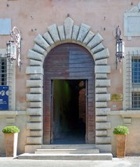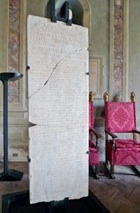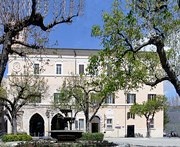
This photograph is courtesy of Cinefotohispellum
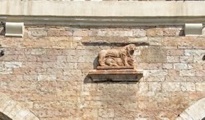

An inscription above the two Gothic arches in the original facade of the palace, to the right of the relief of a lion killing a bull, records that it was constructed in 1270, in the time of the Podestà, Giacomo del Mastro, by the architect, Maestro Prode. At that time, the municipal government was dominated by the Podestà himself and a council of four Priors, supplied by the guilds.
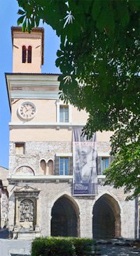
-
✴the Gothic arches in the piazza and the loggia behind, which housed the Monte di Pietà from 1469;

-
✴the barrel-vaulted room behind the loggia (with its entrance in Via Garibaldi), which now houses the Museo delle Infiorate;
-
✴a lunette above the fountain (see below), which now contains a fresco of the Annunciation but which was originally the upper part of a portal that provided access to the first floor and was reached by an external staircase
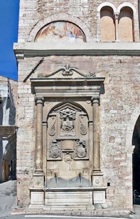
-
✴three bifore windows:
-
•one to the right of the lunette above the fountain; and
-
•two beside the later first floor windows in Via Garibaldi.
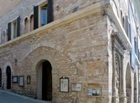
The palace was also used extensively by the Rector of the Duchy of Spoleto and his officials in the decade from 1333. A room on the second floor (see below) contains frescoes of the arms of:
-
✴Pope Clement VI (1342-52); and
-
✴Pope Innocent VI (1352-62).
The re-modeling of the palace began in ca. 1550, when the fountain on the left of the facade in the piazza replaced the external staircase. This fountain bears the arms of Pope Julius III. In 1567-75 , the Lombard architect Battaglia di Pietro extended the palace along the piazza to the right, which necessitated the raising of the level of the piazza itself. The present campanile was also built at this time.
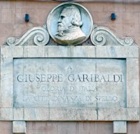
The palace was the seat of the Commune until 1972, when this was moved to nearby Palazzo Urbani. The palace was restored at that point and underwent another major remodeling after the earthquake of 1997.
Interior
The Spello Card allows access to:
-
✴three rooms on the first floor:
-
•the Sala degli Zuccari;
-
•the Sala dell' Editto; and
-
•the Sala di Lettura (used as the reception for visitors), from which the old library can be viewed through a glass door; and
-
✴the three rooms on the second floor that house the Emilio Greco Collection.
Sala degli Zuccari
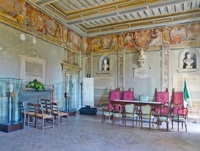
This room is named for the frescoes (16th century) that are traditionally (but unreliably) attributed to the workshop of Federico Zuccari.
View of Spello (1589)
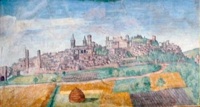
This interesting townscape, which is dated by inscription, is above the door to the Sala dell’ Editto.
Allegorical figures and Views (16th century)

Roman Theatre (16th century)

Rescript of Constantine (ca. 335 AD)
Roman Busts (1st century BC)
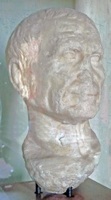
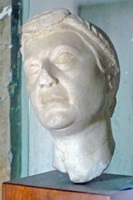
These white marble portrait busts, which are of unknown provenance, probably came from Spello. The female head, which was not documented until the middle part of the 20th century, has been dated on the basis of the lady’s hairstyle.
Sala dell' Editto
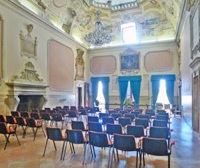
This room on the first floor is named for a fresco of the Rescript of Constantine (to the left of the central window): the original inscription is in the adjacent Sala degli Zuccari (above). The fireplace (late 16th century) on the left wall is made of pietra serena.
Funerary Stele (second half of 1st century BC)
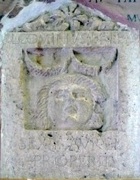
L(ucius) Cominius L(uci) f(ilius) Lem(onia)
The inscription is the earliest of nine surviving inscriptions that confirm that Hispellum (at least from the time of the formation of the colony in ca. 40 BC but possibly from the Social Wars, was assigned to the Lemonia.
The inscription below:
Sext(us) Aurel(ius)/ Propert(ius)/ Sex(ti) f(ilius) Lem(onia)
was added relatively recently (probably in the 18th century) when attempts were being made to claim the poet Propertius (who probably came from Assisi) for Spello.
Copy of Inscription
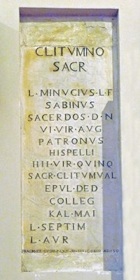
-
“... appropriate to include it in [her paper] since, if the information it contains is authentic, it would constitute rare confirmation of Pliny’s account [in his Letter LXXXVIII to Romanus] of the practices connected with the cult of the god Clitumnus” (my translation, from p. 160).
It claimed to commemorate Lucius Minucius Sabinus, a priest of Clitumnus, who offered a feast for his colleagues on the kalends of May in the year of the consulship of the Emperor Septimius Severus and his son, Marcus Aurelius Severus Antoninus (Caracalla), i.e. 202 AD. The civic cursus of Sabinus was given as:
VI VIR/ AVG
PATRONVS/ HISPEL
IIII VIR QVINQVENN[ALE]
Frescoes (18th century)
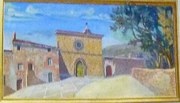
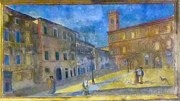
Piazza Vallegloria Palazzo Comunale Vecchio

Madonna di Loreto (1636)
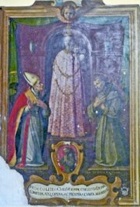
The depicts the Madonna and Child with SS Felix and Francis and (below) the Blessed Andrew Caccioli.
Sala di Lettura
Frescoes (17th century)
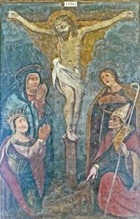
To the sides, frescoed angels draw red drapes to reveal images of two saints above the windows:
-
✴St Francis; and
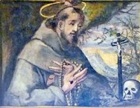
-
✴the Blessed Andrew Caccioli,
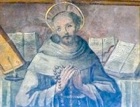
Library
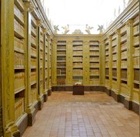
Sala degli Stemmi
This room is named for the 93 paintings (1733) of arms of prominent families by Feliciano Servoli of Foligno. This now serves as the office of the Mayor, and is not open to the public.
Second Floor
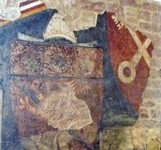

Three rooms on the second floor house the Emilio Greco Collection. One of these rooms contains two recently discovered frescoes of papal insignia belonging to:
-
✴Pope Innocent VI (1352-62), on the left; and
-
✴Pope Clement VI (1342-52), on the right.





